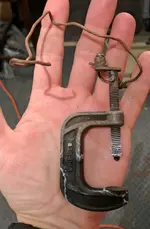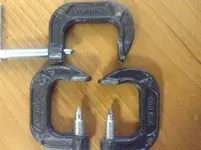Z.K.
Bronze Member
- Joined
- Jun 16, 2015
- Messages
- 1,011
- Reaction score
- 1,412
- Golden Thread
- 0
- Location
- The Grants
- Detector(s) used
- Etrac
- Primary Interest:
- Metal Detecting
Hey folks
Looks like I’ve missed a lot of your great finds in my winter hibernation and have some catching up to do. On the plus side I’ve finally tried my hand at electrolysis and couldn’t be more pleased.
Huge shout out to Brad/OutdoorAdv for being the amazing combination of Obe-Wan Kenobi and Johnny Appleseed of iron preservation that he is: goodwill, technical proficiency, and generosity on and off the forums. You're the man!
This has opened up a whole new dimension to the hobby for me, and I hope those of you who don't do it will consider it. If a technically-challenged guy like me can do it (I'm more of a language and emotion guy, so I top out at oil changes and tree houses ), so can you!
), so can you!
*forgive the pics, I've wrangled with them and can't seem to get them all facing the right way
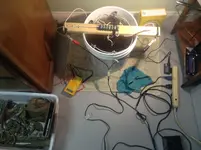
The setup
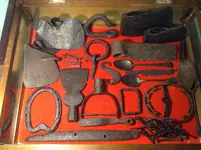
All the iron thus far, with some of the better looking pieces cooked by our good friend OutdoorAdv to show me how it's done. My favorites include the froe, small animal trap, and pitchfork or shovel handle.
I didn't know what the froe was when I dug it, but saw it in some reference books and was very excited to bring it back to life.
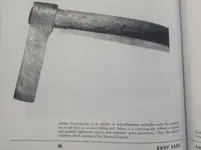
From Henry Kauffman’s American Axes.
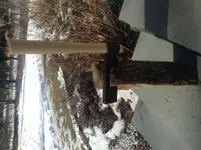
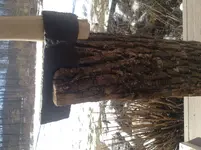
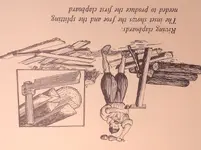
From Colonial Living by Edwin Tunis, p. 22, illustration of froe use in Jamestown settlement

From Tunis’ Frontier Living, p. , illustration of froe use in Piedmont region mid 1700s
Another cool surprise (this one uncovered by Brad) was that a large axehead I had found had a maker's stamp.
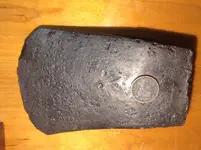
large cent for scale
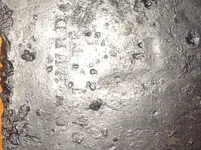
the stamp
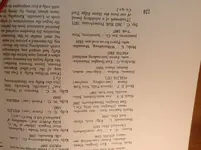
And I found it in a reference! E.F. Hurd. This maker was about 40 miles from where I dug the axe head. Very cool!!
Kauffman’s American Axes again.
Good luck everyone
Looks like I’ve missed a lot of your great finds in my winter hibernation and have some catching up to do. On the plus side I’ve finally tried my hand at electrolysis and couldn’t be more pleased.
Huge shout out to Brad/OutdoorAdv for being the amazing combination of Obe-Wan Kenobi and Johnny Appleseed of iron preservation that he is: goodwill, technical proficiency, and generosity on and off the forums. You're the man!
This has opened up a whole new dimension to the hobby for me, and I hope those of you who don't do it will consider it. If a technically-challenged guy like me can do it (I'm more of a language and emotion guy, so I top out at oil changes and tree houses
 ), so can you!
), so can you!*forgive the pics, I've wrangled with them and can't seem to get them all facing the right way

The setup

All the iron thus far, with some of the better looking pieces cooked by our good friend OutdoorAdv to show me how it's done. My favorites include the froe, small animal trap, and pitchfork or shovel handle.
I didn't know what the froe was when I dug it, but saw it in some reference books and was very excited to bring it back to life.

From Henry Kauffman’s American Axes.



From Colonial Living by Edwin Tunis, p. 22, illustration of froe use in Jamestown settlement

From Tunis’ Frontier Living, p. , illustration of froe use in Piedmont region mid 1700s
Another cool surprise (this one uncovered by Brad) was that a large axehead I had found had a maker's stamp.

large cent for scale

the stamp

And I found it in a reference! E.F. Hurd. This maker was about 40 miles from where I dug the axe head. Very cool!!
Kauffman’s American Axes again.
Good luck everyone
Amazon Forum Fav 👍
Upvote
0




 I was impressed with what you built given those small anode connectors I sent you. haha The cross board you made is more refined than mine. The iron you processed looks amazing. Like I mentioned, I can only tell the difference between what you ran and what I did based on the different wax we each used.
I was impressed with what you built given those small anode connectors I sent you. haha The cross board you made is more refined than mine. The iron you processed looks amazing. Like I mentioned, I can only tell the difference between what you ran and what I did based on the different wax we each used.